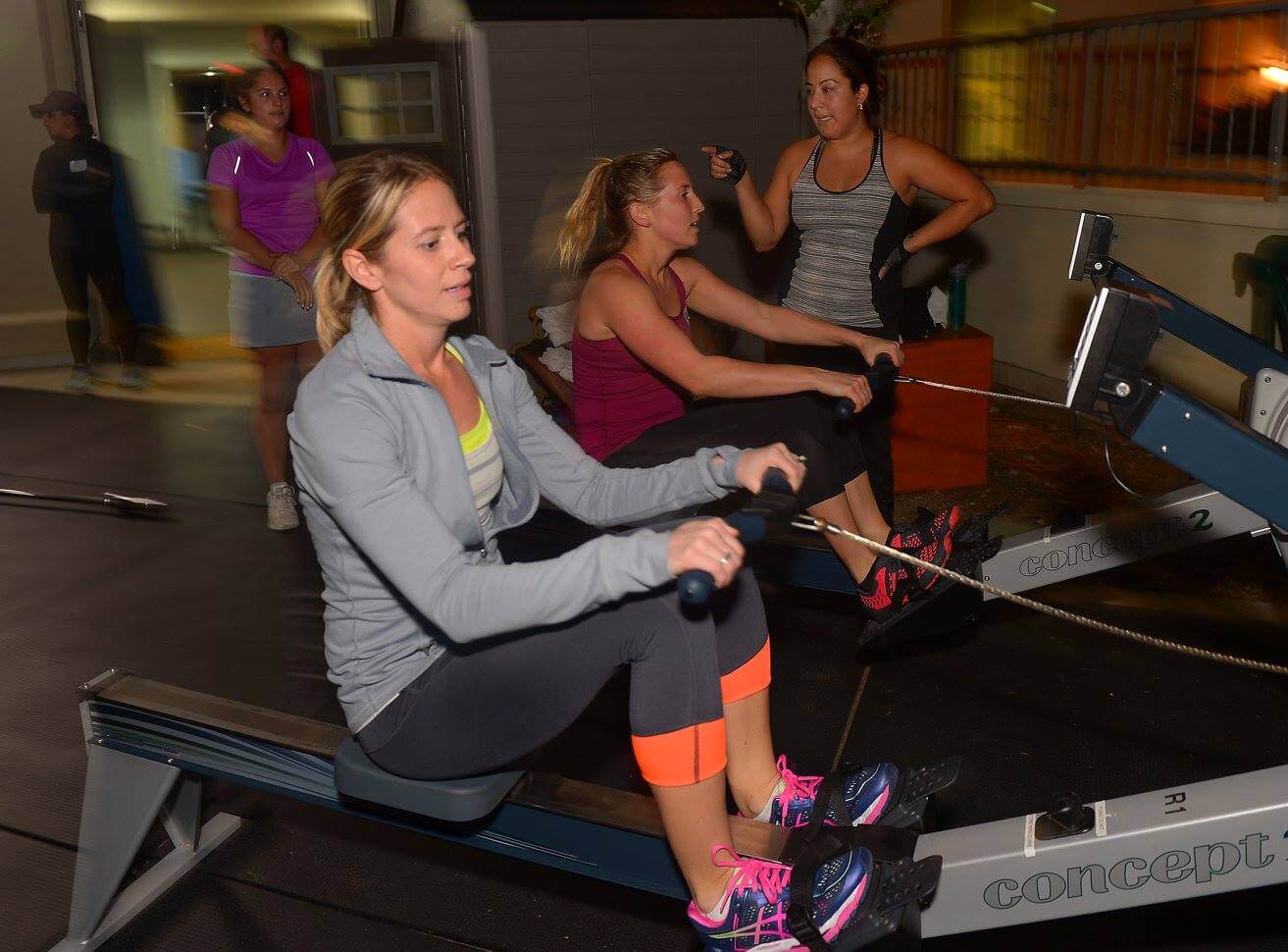Cardio vs Strength Training (and which is the best for you)
September 5th, 2022 | 4 min. read
By Jen Azevedo

There are numerous fitness options at every gym and fitness center near and far. Zumba, Pilates, tennis, swimming, HIIT, volleyball, rock climbing, running, weight lifting, and barre — the options are practically endless.
But one of the age-old questions that often does not get answered is cardio versus strength training, and which is the best for you?
Paseo Club offers group and individual cardio or strength-based training — or a combination of the two. Plus, we know how to assess your fitness level and can help create a plan to get you in shape.
In this article, you will learn what cardio and strength training is, what exercises are associated with each one, the pros and cons, and what happens when the two methods are combined.
Cardio Training›
What is cardio training?
Cardiovascular training, also known as aerobic exercise, is simply doing an exercise that gets your heart rate up.
What are examples of cardio training?
Cardio training encompasses many movements, including sports, functional fitness, and outdoor activities.
- Walking
- Water aerobics
- Jumping jacks
- Swimming
- Cycling
- Jumping rope
- Bear crawls
- Burpees
- Basketball
- Soccer
- Running
What are the benefits of cardio training?
When you do cardio exercise, it increases your heart rate and gets your blood pumping. There are several benefits to cardio training.
- Improves sleep
- Help to maintain a healthy weight
- Regulates blood sugar
- Strengthens the immune system
- Boosts brain function
- Supports mental health
- Lowers blood pressure
- Decreases the risk of heart disease
- Improves lung function
- Increases HDL (good cholesterol)
-jpg.jpeg?width=693&name=12496390_10153562compressed247344261_6525681134516536734_o%20(1)-jpg.jpeg)
What are the drawbacks of cardio training?
Some cardiovascular workouts, such as running, and other high-impact activities, can stress your joints. Doing them repetitively can cause a variety of physical injuries or strains.
Your appetite may increase, and consequently, you may consume more calories, leading to weight gain.
Do we need to do more or less cardio as we age?
A lack of exercise in your adulthood is associated with the onset of disease, an increase in depression and anxiety, and a decrease in one’s physical and mental health.
Flexibility starts to decrease, bone density and muscle mass drop, and recovery between workouts takes longer, beginning in your 50s.
Aging adults still need to do cardio, but because lubrication and cartilage in the joints diminish with age, you may need to change how you get your cardio in.
Many adults swap out basketball, running, and high-intensity aerobics for walking, swimming, and biking. That way, you can still reap the benefits of cardio exercise without wreaking havoc on your joints.
Strength Training
What is strength training?
Strength training, or resistance training, improves strength and endurance. It often involves lifting weights. It can also include calisthenics, isometrics, and plyometrics.
What are examples of strength training?
Strength training is done with many types of equipment and weights or only with your body weight.
Strength training incorporates four different categories.
1. Agile strength is defined as being able to change directions quickly and with power. Some exercises that rely on agile strength are box jumps, shuttle runs, and ladder work.
Sports that require agile strength are often field or court games such as football, soccer, rugby, tennis, and pickleball.
2. Explosive strength is the type of strength used whenever you have to increase force rapidly. Movements that need explosive strength are jumping, throwing, and sprinting.
This type of strength shows up in gymnastics, wrestling, and running, swimming, or biking sprints.
3. Speed strength is characterized by being able to absorb and transmit force rapidly. Speed strength is seen with fast short movements under load.
You use speed strength when doing barbell cycling, Olympic lifting, or plyometric movements such as jump squats, clap push-ups, and jumping rope.
4. Endurance strength is training with a high repetition of movements at a low weight for longer. Calisthenics, isometric exercise (planks, wall sits, glute bridge), and plyometrics require endurance strength.
Yoga and Pilates both require endurance strength.
What are the benefits of strength training
Strength training improves your ability to do everyday activities such as carrying heavy groceries, opening jam jars, weeding in the garden, or dancing at the club.
Strength training also:
- Protects your joints from injury
- Elevates your body image
- Improves muscle definition
- Lowers abdominal fat
- Improves bone health
- Increases energy levels
- Improves your mood
- Improves flexibility and mobility
- Improves brain health
What are the drawbacks of strength training?
Knowing the proper form of each movement is crucial for strength training, especially if you want to use heavy weights. If you are not training correctly, you do risk getting injured. Common injuries include back pain, shoulder pain, and knee pain.
Strength training does not burn calories at the same rate as intense cardio exercise.
Do we need to do more or less strength training as we age?
The older you get, the more you have to work to maintain your muscles. Strength training, in some shape or form, is necessary for older adults to help prevent osteoporosis, frailty, and lean muscle loss.
Great movements that build strength for older adults are incline push-ups, glute bridges, forearm planks, and squats.
Cardio and strength training in combination
What are the benefits of combining cardio and strength training?
Cardio and strength training play different — but essential — roles in our health.
Cardio focuses more on cardiac and respiratory health, oxygen efficiency, and endurance. Strength training enhances muscle and bone development and coordination.
The benefits of engaging in both cardio and strength training are:
- Better blood sugar regulation
- Greater heart health
- Reach and maintain a healthy weight
- Greater overall fitness level — endurance, strength, and balance
- Better injury prevention
Dr. Christopher Mullein, a sports medicine doctor, said. “Each type of exercise has been shown to be beneficial for managing, treating, and preventing a range of health conditions, including diabetes, hypertension, arthritis, cancer, and depression. The combination of both types of exercise may enhance these benefits.”
Is there a specific ratio to follow?
It depends on your goals. If you are training for a specific goal, or sport, there are many kinds of training plans you can follow.
If you are exercising to stay in shape, you should do at least two strength training workouts per week and two to four cardio workouts.
But this is just one approach. There are all kinds of thoughts and opinions on this topic.
How much time should people spend doing each type of training?
How much time you spend exercising depends on your level of fitness and goals. Someone new to exercise may start with as little as 20 minutes at the gym per day.
Some people alternate between cardio and strength on different days while others like to combine their workouts and do cardio and strength together in an hour-long class.
The American College of Sports Medicine (ACSM) recommends both forms of exercise with 150 minutes of moderate-intensity aerobic activity per week and two or more days per week of muscle-strengthening activities.
But there is no way to prescribe a one-size-fits-all approach to fitness. Creating a plan for exercise takes into account the individual, their exercise background, general fitness level, injuries, and goals.
Final thoughts on cardio vs. strength training
Knowing what type of exercise to do, how to work out safely, and how long can be confusing.
Now that you have read this article, we hope you have a better understanding of what cardio and strength training are and their pros and cons. You have also learned about why pairing them together may be the best plan for people of all ages and abilities.
If you are curious about what fitness classes are popular over at the Paseo Club, check out the top 10 fitness classes or see the class calendar.
Alternately, learn how exercise not only makes your body feel better but your mind too.
If you want to get a fitness assessment or check out the indoor/outdoor facilities at Paseo, sign up for a tour today. They are taking visitors every day of the week.
Jen Azevedo is a tennis professional, pickleball professional, personal trainer, group exercise instructor, and the general manager of the Paseo Club. She loves the community at the Paseo Club and that it is also a safe and fun place for her daughter. Jen’s favorite activities are joining her tribe for trail races or her partners for tennis matches. Occasionally Jen slows down to relax with a book — she reads over 100 a year!
Topics:


-jpeg-1.jpeg?width=693&name=IcompressedMG_5222%20(1)-jpeg-1.jpeg)